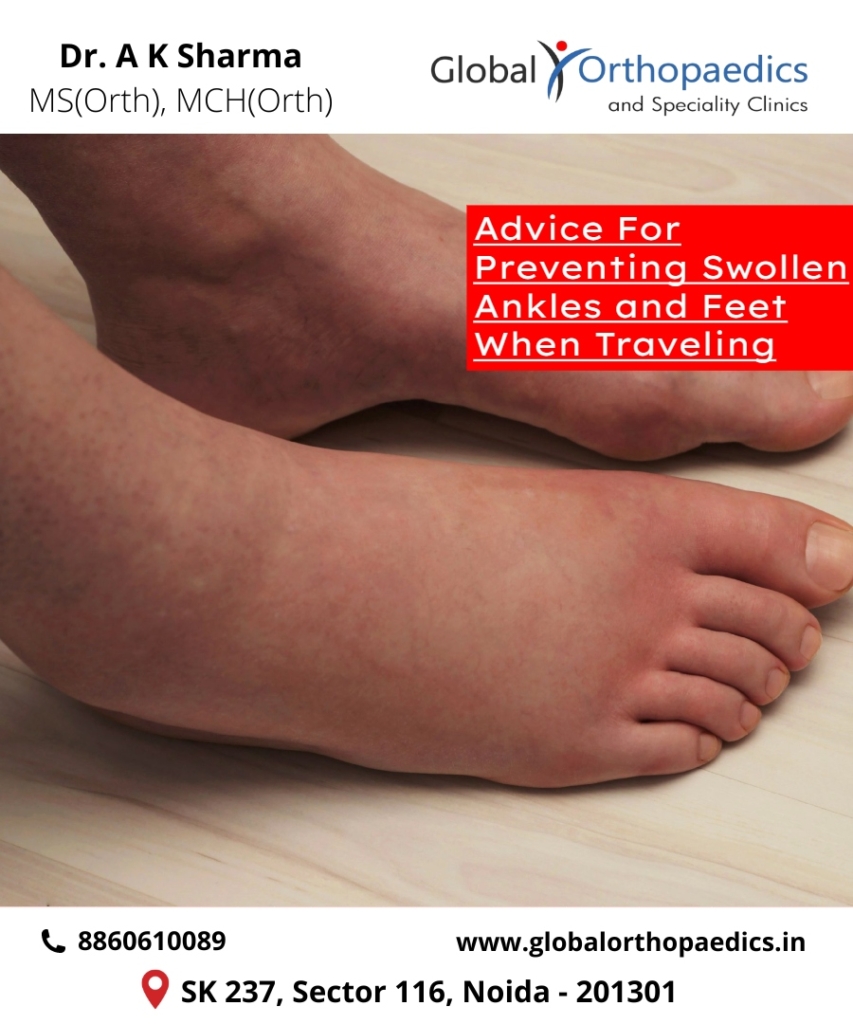Every year, more than two billion people travel by air. Car travels over long distances are also typical. The danger of blood clots and vein thrombosis is elevated by both of these modes of transportation, particularly for individuals who are predisposed to these illnesses.

Many healthy adults experience leg swelling as a result of extended sitting on long-haul flights or while driving. Long-term sitting in a vehicle or aircraft causes the body to go into virtually a static state, reducing the movement of blood and other bodily fluids and causing edema.
Why do ankles and feet swell when traveling?
There are numerous causes for the swelling of your lower legs when you travel. Leg edema is a result of medical conditions that affect certain persons. However, there are further explanations.
The stationary sitting position is one of these. Blood flow in our major arteries and veins is constrained while we sit. Furthermore, you use fewer of your muscles when you sit still. They do not encourage blood flow in veins and do not constrict as they usually do.
Additionally, as you sit, the hydrostatic pressure in your veins rises, increasing the flow of blood across your capillary membrane and into the interstitial space, which is why you get swelling.
How to prevent swelling feet and ankles
There are ways to lessen the chance of swollen feet while traveling, even though it could seem impossible to prevent.
Workout
Exercises that involve raising and lowering the heel and toe, ankle circles, and foot pumps while traveling can all help to contract the calf muscles. Try to keep your lower legs as active as possible.
One study demonstrated the benefits of resistance-training workouts for long-haul travelers. The blood flow was boosted by these exercises.
Furthermore, it’s critical to rotate your knee joints in a flexed and extended position to improve blood flow, muscular activation, and popliteal release (the hollow in the back of the knee).
Exercises can increase the mobility of the calf muscles and aid in the removal of fluids through muscular contraction. Ankle and foot swelling can be further reduced by wearing compression clothing.
Stretch
It’s crucial to stretch your calf muscles because they become dormant during lengthy vehicle and airplane rides. Toe-pointing upward will help you stretch your calf muscles. Lean slightly forward and stretch your leg if there is more room. This also aids in hamstring stretches.
Moreover, take advantage of any opportunity for a quick pause when driving. Stretching will be simpler once you are outside the vehicle. Stretching the hip flexors and front of the thighs is a wise decision. Thus, while standing on one leg, place your foot in your rear arm, bend your knee, and bring it up to your glutes. while maintaining the standing leg’s parallel to your thigh. Continue with a different leg.
Position
Avoid crossing your legs as this further narrows blood flow due to compressed large arteries and veins. In addition, it may make your back more uncomfortable.
You will be able to retain the normal curvature of your lumbar spine and have less tension in your spine if you are able to obtain lumbar support.
It’s important to remember that maintaining a static posture causes your body to become more tense and decreases blood flow and muscle activity. Attempt to extend your spine from the top of your head, rotate your trunk to one side and another, and lean forward and backward. You can perform these workouts while driving or flying.
The Ergonomics
The flexibility to modify the seat height is crucial for blood volume flow. Blood flow is decreased in the popliteal region, which is the back of your knee. Particularly in toddlers or those with short legs, not being able to touch the floor with your feet causes more compression in the popliteal region. In general, this is worse in a flight than it is in a car because of how poorly seats can be adjusted.
Put some support beneath your child’s feet, though, if they seem to be hanging. You’ll be able to prevent limitations in the popliteal region after extended travel, and your legs will feel much better.
If you or your child nods off while traveling, make sure that your body is in a comfortable position and that your head is supported on the sides and back. If not, your child’s neck will hurt when they wake up.
Clothes
Avoiding restrictive clothing will also help you breathe and move more freely. When traveling, stay away from wearing tight pants, especially around the belly, and allow your abdomen to move freely when you breathe.
For long vehicle rides or flights, wear loose, comfortable attire. If at all possible, take off your outermost layers of clothing to further increase your range of motion.
Additionally, put on cozy socks and shoes that won’t limit the range of motion in your fingers, foot, or ankles.
Water
Maintaining proper hydration is crucial since consuming adequate water can lessen edema. Blood viscosity rises with dehydration, reducing blood flow and altering blood chemistry. Dehydration is exacerbated by the low humidity in an airplane cabin, so make sure you get enough water before, during, and after the trip without adding any sweeteners.
In order to stay hydrated, it’s also critical to cut back on the caffeine in tea, coffee, and other beverages.
For additional advice on long-haul flights and road journeys, consult with Dr. A K Sharma – the best orthopaedic doctor in Noida if you are at higher risk of thromboembolism or blood clots.
Book an appointment by visit our website: www.globalorthopaedics.in or by calling at 8860610089.


